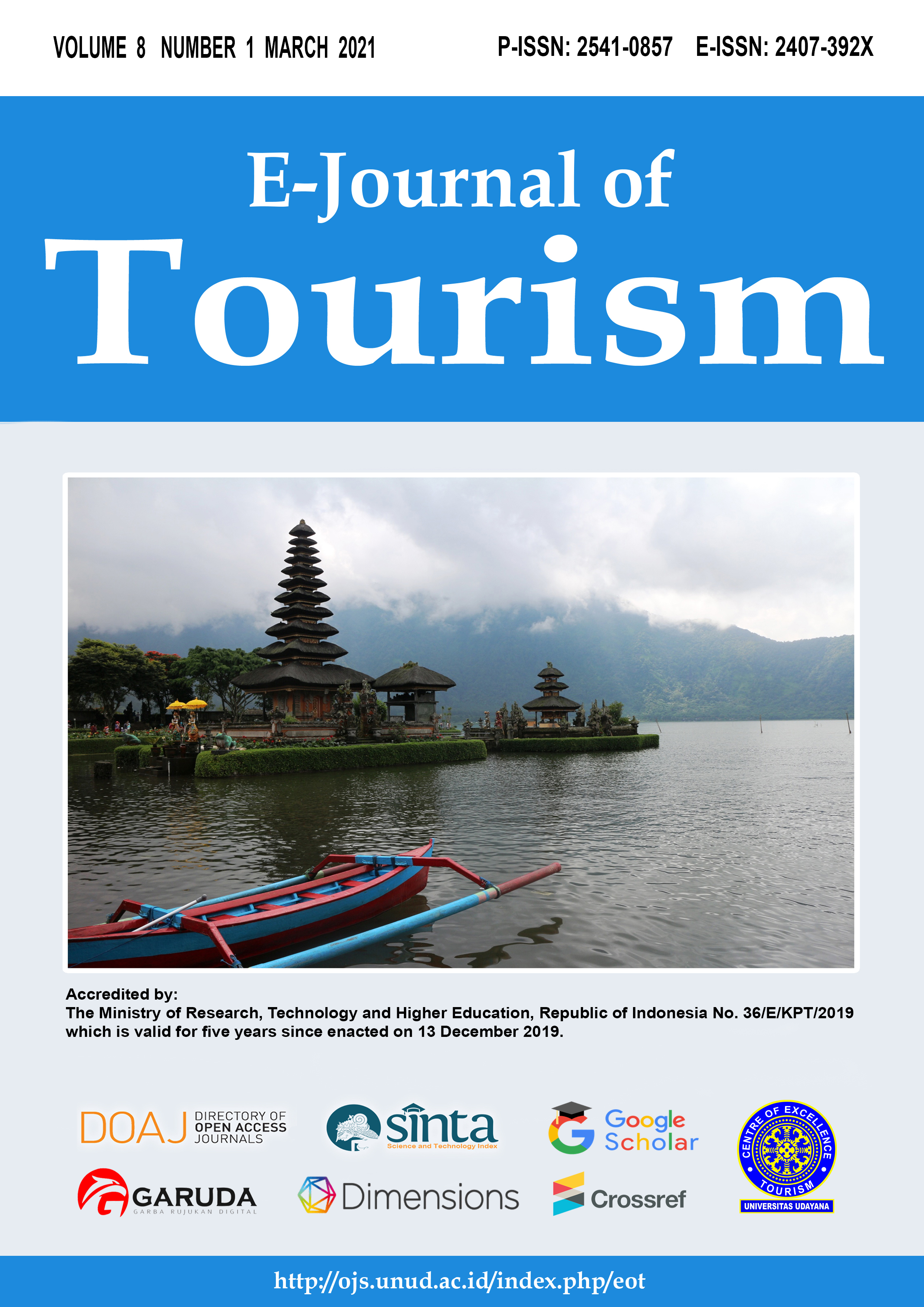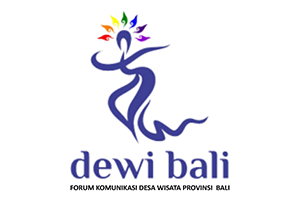On Different Perspective: Image of Yogyakarta as a Tourist Destination from Domestic and International Tourist’s Perception
Abstract
This study examines the differences in how domestic and international tourists perceived the image of Yogyakarta as a tourist destination. This survey-based quantitative research used online-questionnaire to collect data from the domestic and international tourists who have visited Yogyakarta. Using a non-probability convenience sampling method, 304 useable questionnaire responses were collected through any social media network. The image of Yogyakarta as a tourist destination in this study consists of four parts: top of mind image, destination visual image selection, cognitive and affective evaluation. To test the different perspectives about cognitive and affective components of an image between domestic and international tourists, a non-parametric Mann-Whitney u-test was performed. The result shows that there is a significant difference in cognitive evaluation about an image of Yogyakarta as a destination nevertheless, no significant difference was found in the affective evaluation. The differences also appeared in the part of visual image selection whereas domestic tourists mostly choose Malioboro as the best picture to describe Yogyakarta while international tourists choose a Temple more than others. At the top-of-mind, international tourists mentioned Borobudur as a part of heritage sites and history frequently while most domestic tourists mentioned art and culture, shopping, and culinary. Furthermore, a methodological issue and practical implication are also discussed.
Downloads
References
Baloglu, S. (2001) ‘Image variations of Turkey by familiarity index: informational and experiential dimensions’, Tourism Management. doi: 10.1016/s0261-5177(00)00049-2.
Baloglu, S. and Brinberg, D. (1997) ‘Affective images of tourism destinations’, Journal of Travel Research. doi: 10.1177/004728759703500402.
Baloglu, S. and Mangaloglu, M. (2001) ‘Tourism destination images of Turkey, Egypt, Greece, and Italy as perceived by US-based tour operators and travel agents’, Tourism Management. doi: 10.1016/S0261-5177(00)00030-3.
Baloglu, S. and McCleary, K. W. (1999) ‘A model of destination image formation’, Annals of Tourism Research. doi: 10.1016/S0160-7383(99)00030-4.
Biro Pusat Statistik (2018) Statistik Wisatawan Nusantara, Biro Pusat Statsitik.
Bonn, M. A., Joseph, S. M. and Dai, M. (2005) ‘International versus domestic visitors: An examination of destination image perceptions’, Journal of Travel Research. doi: 10.1177/0047287504272033.
Chen, C. F. and Tsai, D. C. (2007) ‘How destination image and evaluative factors affect behavioral intentions?’, Tourism Management. doi: 10.1016/j.tourman.2006.07.007.
Coban S (2012) ‘The effects of the image of destination on tourist satisfaction and loyalty: The case of Cappadocia’, European Journal of Social Sciences.
Cooper, Chris; Fletcher, John; Fyall Alan; Gilbert, David; & Wanhill, S. (2008) Tourism Principles and Practice. Fourth Edi. London: Prentice Hall.
Crompton, J. L. (1979) ‘An assessment of the image of Mexico as a vacation destination and the influence of geographical location upon that image’, Journal of travel research, 17(4), pp. 18–23.
Dinas Pariwisata DIY (2019) ‘Statistik Kepariwisataan 2019’, Dinas Pariwisata Daerah Istimewa Yogyakarta.
Echtner, C. M. and Ritchie, J. R. B. (1993) ‘The Measurement of Destination Image: An Empirical Assessment’, Journal of Travel Research. doi: 10.1177/004728759303100402.
Fakeye, P. C. and Crompton, J. L. (1991) ‘Image Differences between Prospective, First-Time, and Repeat Visitors to the Lower Rio Grande Valley’, Journal of Travel Research. doi: 10.1177/004728759103000202.
Gallarza, M. G., Saura, I. G. and García, H. C. (2002) ‘Destination image: Towards a conceptual framework’, Annals of Tourism Research. doi: 10.1016/S0160-7383(01)00031-7.
Gartner, W. C. (1994) ‘Image formation process’, Journal of travel & tourism marketing, 2(2–3), pp. 191–216.
Hampton, M. (2005) ‘Heritage, local communities and economic development’, Annals of Tourism Research. doi: 10.1016/j.annals.2004.10.010.
Hunter, W. C. (2008) ‘A typology of photographic representations for tourism: Depictions of groomed spaces’, Tourism Management. doi: 10.1016/j.tourman.2007.03.008.
Kemenpar (2018) ‘Data Kunjungan Wisatawan Mancanegara Bulanan Tahun 2018’, Kemenpar.
Khairani, K. and Setyowardhani, H. (2013) ‘Analysis on Variables Affecting the Creation of Tourist Destination Image: Case Study on Domestic Tourists Visiting Yogyakarta between 2007 to 2009’, ASEAN Marketing Journal. doi: 10.21002/amj.v2i1.1992.
Konecnik, M. and Gartner, W. C. (2007) ‘Customer-based brand equity for a destination’, Annals of tourism research, 34(2), pp. 400–421.
Kotler, P. and Gertner, D. (2002) ‘Country as brand, product, and beyond: A place marketing and brand management perspective’, Journal of Brand Management. doi: 10.1057/palgrave.bm.2540076.
Law, R., Kozak, M. and Crotts, J. C. (2007) ‘The impact of the perception of risk on international travellers.’, International Journal of Tourism Research.
Liu, X., Li, J. J. and Kim, W. G. (2017) ‘The role of travel experience in the structural relationships among tourists’ perceived image, satisfaction, and behavioral intentions’, Tourism and Hospitality Research. doi: 10.1177/1467358415610371.
MacKay, K. J. and Fesenmaier, D. R. (2000) ‘An exploration of cross-cultural destination image assessment’, Journal of travel research, 38(4), pp. 417–423.
Matteucci, X. (2013) ‘Photo elicitation: Exploring tourist experiences with researcher-found images’, Tourism Management. doi: 10.1016/j.tourman.2012.07.002.
Mayo, E. (1975) ‘Tourism and the National Parks: A Psychographic and Attitudinal Study’, Journal of Travel Research. doi: 10.1177/004728757501400103.
Molinillo, S. et al. (2018) ‘DMO online platforms: Image and intention to visit’, Tourism Management. doi: 10.1016/j.tourman.2017.09.021.
Nurazizah, G. R. and Marhanah, S. (2020). Influence of destination image and travel experience towards revisit intention in yogyakarta as tourist destination. Journal of Indonesian Tourism, Hospitality and Recreation. doi: 10.17509/jithor.v3i1.23016.
Prayag, G. and Ryan, C. (2012) ‘Antecedents of tourists’ loyalty to mauritius: The role and influence of destination image, place attachment, personal involvement, and satisfaction’, Journal of Travel Research. doi: 10.1177/0047287511410321.
Quintal, V., Phau, I. and Polczynski, A. (2014) ‘Destination brand image of Western Australia’s South-West region: Perceptions of local versus international tourists’, Journal of Vacation Marketing. doi: 10.1177/1356766713490163.
Rao, P. S. (2019) ‘The role of english as a global language’, Research Journal of English.
Ross, G. F. (1998) The Psychology of Tourism. Second edi. Melbourne: Hospitality Press Pty Ltd, Melbourne.
Santoso, S. (2019) ‘Examining Relationships between Destination Image, Tourist Motivation, Satisfaction, and Visit Intention in Yogyakarta’, Expert Journal of Business and Management, 7(1), pp. 82–90.
Sekaran, U. and Bougie, R. (2016) ‘Research Method for Business Textbook: A Skill Building Approach’, John Wiley & Sons Ltd.
Slak Valek, N. and Williams, R. B. (2018) ‘One place, two perspectives: Destination image for tourists and nationals in Abu Dhabi’, Tourism Management Perspectives. doi: 10.1016/j.tmp.2018.06.004.
Stepchenkova, S. and Li, X. (2014) ‘Destination image: Do top-of-mind associations say it all?’, Annals of Tourism Research. doi: 10.1016/j.annals.2013.12.004.
Stone, L. S. and Nyaupane, G. P. (2019) ‘The Tourist Gaze: Domestic versus International Tourists’, Journal of Travel Research. doi: 10.1177/0047287518781890.
Tasci, A. D. A., Gartner, W. C. and Tamer Cavusgil, S. (2007) ‘Conceptualization and Operationalization of Destination Image’, Journal of Hospitality and Tourism Research. doi: 10.1177/1096348006297290.
Timothy, D. J. and Wall, G. (1997) ‘Selling to tourists: Indonesian Street Vendors’, Annals of Tourism Research. doi: 10.1016/S0160-7383(97)80004-7.
Triandis, H. C. (1994) Culture and Social Behavior. Edited by F. H. Rogers, Christopher; Sofer, Nomi; & Burns. New York: McGraw-Hill, Inc.
UNWTO (2020) ‘International tourism faces deepest crisis in history •’, World Tourism Barometer.
Ye, H. and Tussyadiah, I. P. (2011) ‘Destination visual image and expectation of experiences’, Journal of Travel and Tourism Marketing. doi: 10.1080/10548408.2011.545743.
Yusuf, M. (2017) ‘Measuring Tourist’s Motivations for Consuming Local Angkringan Street Food in Yogyakarta, Indonesia’, Journal of Indonesian Tourism and Development Studies. doi: 10.21776/ub.jitode.2017.005.02.01.

This work is licensed under a Creative Commons Attribution 4.0 International License.
The copyright of the received article shall be assigned to the journal as the publisher of the journal. The intended copyright includes the right to publish the article in various forms (including reprints). The journal maintains the publishing rights to the published articles.




















